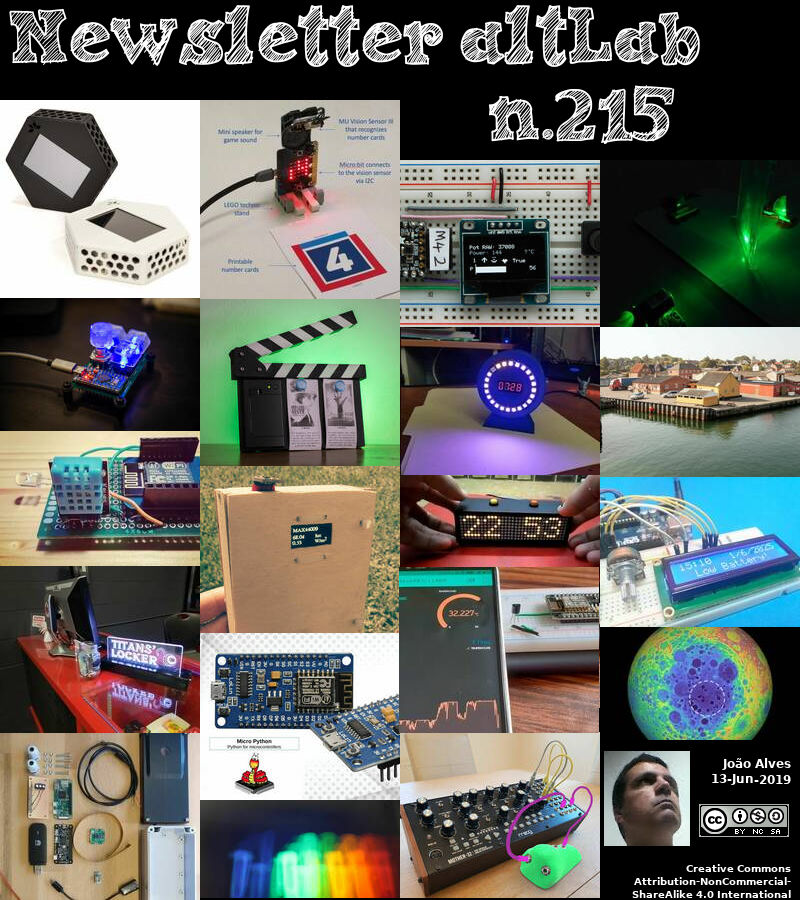2019-06-13 - Nº 215
Editorial
Esta é a Newsletter Nº 215 que se apresenta com o mesmo formato que as anteriores. Se gostar da Newsletter partilhe-a!
Todas as Newsletters encontram-se indexadas no link.
Esta Newsletter tem os seguintes tópicos:
Faz hoje anos que nascia, em 1773, Thomas Young. Este físico e egiptólogo inglês reforçou a teoria ondulatória da luz com seu estudo da interferência da luz. Como estudante de medicina, descobriu como a forma das lentes do olho mudam para se focarem. Em 1801, ele reconheceu a causa do estigmatismo. Young demonstrou a natureza ondulatória da luz, polarização de luz, franjas de interferência e explicou as cores vistas em camadas finas, como bolhas de sabão. Ele associava o comprimento de onda com a cor da luz e a percepção do olho de qualquer cor como uma mistura de vermelho, azul e verde. O módulo de Young é o nome dados decorrente do seu trabalho com elasticidade. Ele também trabalhou medindo o tamanho das moléculas, a tensão superficial do líquido. Ele também foi um egiptólogo que ajudou a decifrar a Pedra de Roseta.
Faz também anos hoje que nascia, em 1831, James Clerk Maxwell. Este físico e matemático escocês fez pesquisas que uniram electricidade e magnetismo ao conceito do campo electromagnético. Em Londres, por volta de 1862, Maxwell calculou que a velocidade de propagação de um campo electromagnético é aproximadamente a velocidade da luz. Ele propôs que o fenómeno da luz é, portanto, um fenómeno electromagnético. As quatro equações diferenciais parciais, agora conhecidas como equações de Maxwell, apareceram pela primeira vez em forma totalmente desenvolvida em Electricity and Magnetism (1873). Ele morreu relativamente jovem; Algumas das teorias que ele avançou em física só foram conclusivamente provadas muito depois de sua morte. As ideias de Maxwell também abriram o caminho para a teoria da relatividade especial de Einstein e a teoria quântica.
Faz igualmente anos hoje que nascia, em 1854, Charles Algernon Parsons. Este engenheiro britânico inventou uma turbina a vapor de múltiplos estágios que revolucionou a propulsão marítima (1884). Cada estágio foi projectado para controlar e maximizar a potência fornecida. Em 1891, ele projectou a sua turbina com um condensador para alimentar dínamos em estações geradoras eléctricas. Em 1897, usando a sua turbina para alimentar seu navio de 100 pés Turbinia, ele alcançou 35 nós. O primeiro navio a ser impulsionado por turbinas, com sua incrível velocidade, levou à construção de muitos navios de guerra movidos a turbina para a marinha britânica. Ele melhorou ainda mais a eficiência com um redutor mecânico para ligar o motor às hélices. Parsons também inventou um dispositivo para melhorar os fonógrafos, foi pioneiro na aviação e produziu um dispositivo antiderrapante para pneus de automóveis.
Faz também anos hoje que nascia, em 1903 - Willard Harrison Bennett. Este físico norte-americano descobriu, em 1934, o efeito de pinça, um processo electromagnético que pode oferecer uma maneira de confinar magneticamente um plasma a temperaturas altas o suficiente para que ocorram reacções controladas de fusão nuclear. Ele propôs em 1936 o acelerador Van de Graaff, que mais tarde se tornou amplamente utilizado na pesquisa nuclear. Ele inventou um espectrómetro de massa de radiofrequência, desenvolvido em 1955. Como não exigia nenhum íman pesado, foi o primeiro lançado ao espaço para medir as massas de átomos. O Sputnik III levou o primeiro espectrómetro de massa R-F para o espaço. Foi o único instrumento espacial usado pelos russos e creditado a um inventor americano nas suas próprias publicações em língua russa.
Faz igualmente anos hoje que nasciam, em 1911, Erwin Wilhelm Müller e Luis Walter Alvarez. O primeiro foi um físico germano-americano que inventou o microscópio de emissão de campo (FIM), que forneceu ampliações superiores a um milhão. Pela primeira vez, foi possível tirar fotos de átomos individuais. Imagens das estruturas atómicas do tungsténio foram publicadas pela primeira vez em 1951 na revista Zeitschrift für Physik. Na MIF, uma voltagem de cerca de 10kV é aplicada a uma ponta de metal afiada, arrefecida abaixo de 50 kelvin numa atmosfera de hélio de baixa pressão. Átomos de gás são ionizados pelo forte campo eléctrico na vizinhança da ponta e repelidos perpendicularmente à superfície da ponta. Um detector desenha a distribuição espacial desses iões, dando uma ampliação da curvatura da superfície. O segundo foi um físico americano que recebeu o Prémio Nobel de Física em 1968 pelo trabalho que incluiu a descoberta de muitas partículas de ressonância (partículas subatómicas tendo vidas extremamente curtas e ocorrendo apenas em colisões nucleares de alta energia). Alvarez inventou uma distância de rádio e um indicador de direcção. Durante a Segunda Guerra Mundial, ele projectou um sistema de pouso para aeronaves e um sistema de radar para localizar aviões. Ele participou do desenvolvimento da bomba atómica no Laboratório Científico de Los Alamos (1944-45). Ele sugeriu a técnica para detonar o tipo de implosão de bomba atómica. Mais tarde, ele ajudou a desenvolver a câmara de bolhas de hidrogénio, usada para detectar partículas subatómicas. Esta pesquisa levou à descoberta de mais de 70 partículas elementares e resultou numa grande revisão das teorias nucleares.
Por fim, faz anos hoje que nascia, em 1928, John Forbes Nash Jr.. Este matemático norte-americano fez contribuições fundamentais para a teoria dos jogos, geometria diferencial e o estudo de equações diferenciais parciais. O trabalho de Nash forneceu detalhes sobre os factores que governam o acaso e a tomada de decisões dentro de sistemas complexos encontrados na vida quotidiana. As suas teorias são amplamente utilizadas na economia. Actuando como Matemático de Pesquisa Sénior na Universidade de Princeton durante a parte posterior de sua vida, ele repartiu o Prémio Nobel de 1994 em Ciências Económicas com os teóricos dos jogos Reinhard Selten e John Harsanyi. Em 2015, ele também dividiu o Prémio Abel com Louis Nirenberg por seu trabalho sobre equações diferenciais parciais não-lineares. John Nash é a única pessoa a receber o Prémio Nobel em Ciências Económicas e o Prémio Abel.
Nesta semana que passou ficámos a saber que a SpaceX lançou com sucesso três satélites Canadianos RADARSAT (RCM). O Foguetão Falcon-9 foi lançado e após a sua missão voltou à Terra tendo sido recuperado com sucesso. Os três satélites lançados são do tipo C-Band SAR (Radar de Abertura Sintética) para observação terrestre. De entre as missões destes satélites o RCM fornecerão revisitas diárias ao vasto território e abordagens marítimas do Canadá, incluindo o Árctico, até 4 vezes por dia, bem como acesso diário a qualquer ponto de 90% da superfície da Terra. Estes satélites irão substituir os RADARSAT-2, lançados em 2007.
Na Newsletter desta semana apresentamos diversos projetos de maker assim como um modelo 3D. É apresentado manual de operação do computador ENIAC.
 João Alves ([email protected])
João Alves ([email protected])
O conteúdo da Newsletter encontra-se sob a licença  Creative Commons Attribution-NonCommercial-ShareAlike 4.0 International License.
Creative Commons Attribution-NonCommercial-ShareAlike 4.0 International License.
Novidades da Semana

RADARSAT Constellation Mission
"SpaceX is targeting Wednesday, June 12 for launch of RADARSAT Constellation Mission from Space Launch Complex 4E (SLC-4E) at Vandenberg Air Force Base in California. The primary launch window opens at 7:17 a.m. PDT, or 14:17 UTC, and closes at 7:30 a.m. PDT, or 14:30 UTC. The satellites will begin deployment approximately 54 minutes after launch. A backup launch window opens on Thursday, June 13 at 7:17 a.m. PDT, or 14:17 UTC, and closes at 7:30 a.m. PDT, or 14:30 UTC. Falcon 9’s first stage for launch of RADARSAT Constellation Mission previously supported Crew Dragon’s first demonstration mission in March 2019. Following stage separation, Falcon 9’s first stage will return to land on SpaceX’s Landing Zone 4 (LZ-4) at Vandenberg Air Force Base." [...]
Outras Notícias
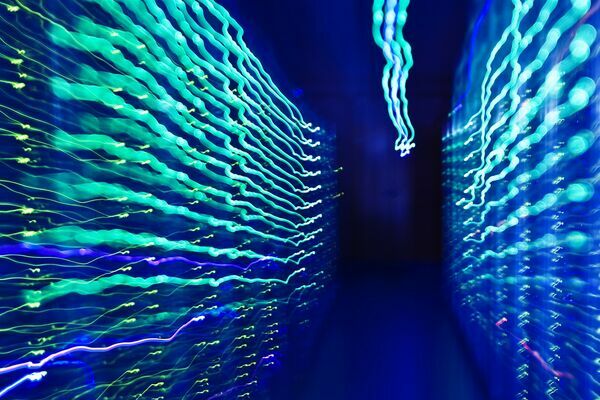
Microsoft Alternatives project (MAlt)
"The Microsoft Alternatives project (MAlt) started a year ago to mitigate anticipated software license fee increases. MAlt’s objective is to put us back in control using open software. It is now time to present more widely this project and to explain how it will shape our computing environment. Background Over the years, CERN’s activities and services have increasingly relied on commercial software and solutions to deliver core functionalities, often leveraged by advantageous financial conditions based on the recognition of CERN’s status as an academic, non-profit or research institute. Once installed, well-spread and heavily used, the leverage used to attract CERN service managers to the commercial solutions tends to disappear and be replaced by licensing schemes and business models tuned for the private sector. Given the collaborative nature of CERN and its wide community, a high number of licenses are required to deliver services to everyone, and when traditional business models on a per-user basis are applied, the costs per product can be huge and become unaffordable in the long term." [...]

Hyundai and Kia Invest in Aurora
"Partnership continues development on self-driving platforms and services powered by the Aurora Driver Today we’re pleased to announce that our existing partner Hyundai Motor Group, which includes Hyundai Motor Company and Kia Motors Corporation, has invested in Aurora as part of our Series B financing round. We’ve now raised more than $600 million as part of our Series B financing, putting us in a strong position to accelerate the development of the Aurora Driver, strengthen our team, and acquire cutting-edge technology. We’ve been working with Hyundai and Kia for the last year to develop the Aurora Driver’s integration into Hyundai’s flagship fuel cell vehicle NEXO. Continuing our partnership, we will expand research and development of a self-driving platform for a wide range of Hyundai and Kia’s models. “We are pleased with the progress made with the Hyundai and Kia teams,” said Sterling Anderson, Co-founder and Chief Product Officer of Aurora. “Together with all of our ecosystem partners, we are seeing the convergence of a powerful platform that will deliver the benefits of self-driving technology safely, quickly, and broadly.” “Aurora is the leading innovator of self-driving technology and we look forward to building a stronger collaborative partnership with them,” said Youngcho Chi, President and Chief Innovation Officer at Hyundai Motor Group." [...]
Ciência e Tecnologia
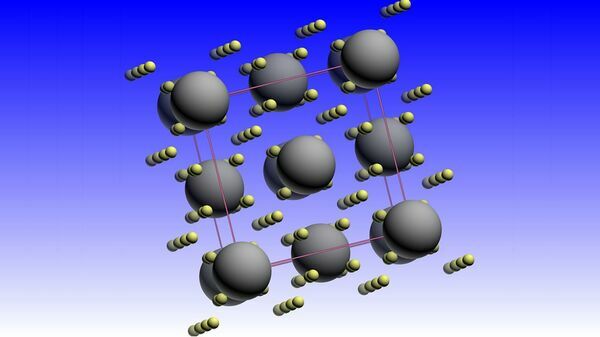
Scientists break record for highest-temperature superconductor
"Experiment produces new material that can conduct electricity perfectly University of Chicago scientists are part of an international research team that has discovered superconductivity—the ability to conduct electricity perfectly—at the highest temperatures ever recorded. Using advanced technology at UChicago-affiliated Argonne National Laboratory, the team studied a class of materials in which they observed superconductivity at temperatures of about minus-23 degrees Celsius (minus-9 degrees Fahrenheit)—a jump of about 50 degrees compared to the previous confirmed record. Though the superconductivity happened under extremely high pressure, the result still represents a big step toward creating superconductivity at room temperature—the ultimate goal for scientists to be able to use this phenomenon for advanced technologies. The results were published May 22 in the journal Nature; Vitali Prakapenka, a research professor at the University of Chicago, and Eran Greenberg, a postdoctoral scholar at the University of Chicago, are co-authors of the research. Just as a copper wire conducts electricity better than a rubber tube, certain kinds of materials are better at becoming superconductive, a state defined by two main properties: The material offers zero resistance to electrical current and cannot be penetrated by magnetic fields. The potential uses for this are as vast as they are exciting: electrical wires without diminishing currents, extremely fast supercomputers and efficient magnetic levitation trains." [...]
Probing Semiconductor Crystals with a Sphere of Light
"Tohoku University researchers have developed a technique using a hollow sphere to measure the electronic and optical properties of large semiconducting crystals. The approach, published in the journal Applied Physics Express, improves on current photoluminescence spectroscopy techniques and could lead to energy savings for mass producers, and thus consumers, of power devices. Semiconducting crystals are used to make electronic devices like microprocessor chips and transistors. Manufacturers need to be able to detect crystal defects and test their energy conversion efficiency. One way to do this is to measure their 'internal quantum efficiency', or their ability to generate photons from electrons excited by an electric current or an excitation laser. Currently available methods limit the sample size that can be tested at a time." [...]

A step towards fully electric ferries
"Hybrid and electric vessels are under the spotlight lately, thanks to intensified efforts to limit greenhouse gas emissions from global shipping, a significant source of CO2 and other pollutants. There are already several offerings of such green ships in Europe, and a Danish operator is ready to pave the way for the widespread use of fully electric powered vessels in the ferry sector. Supported by the EU-funded E-ferry project, project partner Aeroe (Ærø) Kommune’s vessel will cover distances of over 20 NM between charges. The novel all-electric ferry is set to have the largest battery pack installed at sea. A news item on ‘Passenger Ship Technology’ states that the new vessel is “likely to be the first electric ferry to have no emergency back-up generator.” It adds: “Creating this E-ferry prototype Ellen, due for delivery in May, involved designing, building and demonstrating a fully electric-powered ‘green’ ferry which can sail without CO2 emissions.” The same news item notes that the battery system of the vessel is divided into 20 different units. Each unit is connected to separate converters that control the energy output." [...]
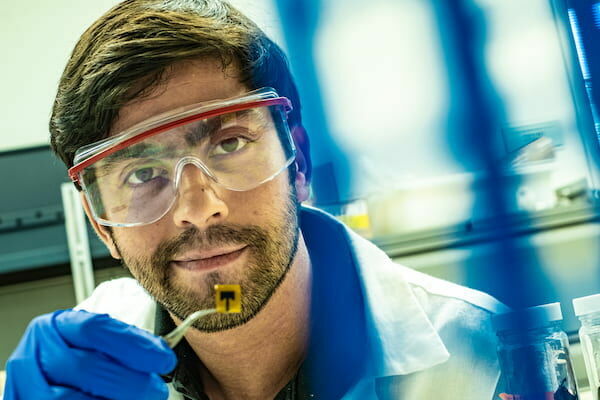
Antennas of flexible nanotube films an alternative for electronics
"Rice lab claims a viable competitor for copper in 5G wireless and other applications Antennas made of carbon nanotube films are just as efficient as copper for wireless applications, according to researchers at Rice University’s Brown School of Engineering. They’re also tougher, more flexible and can essentially be painted onto devices. The Rice lab of chemical and biomolecular engineer Matteo Pasquali tested antennas made of “shear-aligned” nanotube films. The researchers discovered that not only were the conductive films able to match the performance of commonly used copper films, they could also be made thinner to better handle higher frequencies. The results detailed in Applied Physics Letters advance the lab’s previous work on antennas based on carbon nanotube fibers. The lab’s shear-aligned antennas were tested at the National Institute of Standards and Technology (NIST) facility in Boulder, Colorado, by lead author Amram Bengio, who carried out the research and wrote the paper while earning his doctorate in Pasquali’s lab." [...]
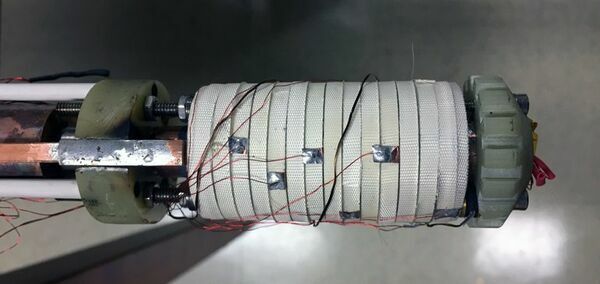
With mini magnet, National MagLab creates world-record magnetic field
"The compact coil could lead to a new generation of magnets for biomedical research, nuclear fusion reactors and many applications in between. Any featherweight who steps into the ring with a heavyweight must either be crazy or harbor a death wish. Yet that happened at the National High Magnetic Field Laboratory recently, when a novel magnet half the size of a spent toilet tissue roll usurped the title of "world's strongest magnetic field" from the metal titan that had held it for two decades. And, its makers say, we ain't seen nothing yet: By packing an exceptionally high-field magnet into a coil you could pack in a purse, MagLab scientists and engineers have shown a way to build and use electromagnets that are stronger, smaller and more versatile than ever before. Their work is outlined in an article published today in the journal Nature. "We are really opening a new door," said MagLab engineer Seungyong Hahn, the mastermind behind the new magnet and a professor at the FAMU-FSU College of Engineering." [...]
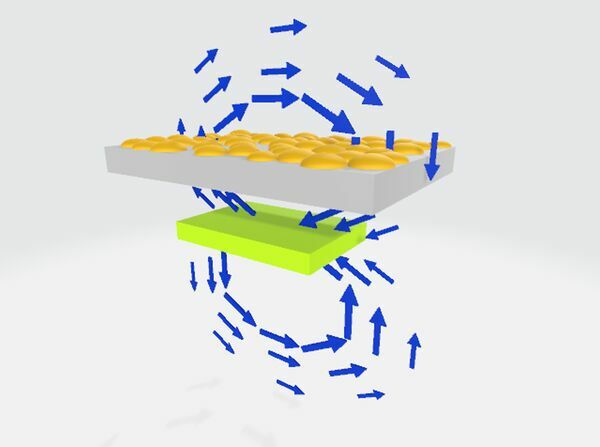
Good Vibrations: Using Piezoelectricity to Ensure Hydrogen Sensor Sensitivity
"A team at Osaka University has invented a new process for creating high-precision sensing devices that respond to the presence of hydrogen gas. By carefully controlling the deposition of metallic nanoparticles on a silicon surface, the researchers were able to create a sensor that can detect low levels of hydrogen on the basis of changes in electrical current. This research may have important benefits as part of a switch to hydrogen-based fuels, which could power the zero-emission cars of the future and help fight anthropogenic climate change. To fabricate a hydrogen sensor, the researchers deposited metallic palladium on a silicon substrate. The deposited palladium forms nanoparticles on the substrate, and they act like tiny islands that are excellent conductors of electricity, but, because they do not form a connected network, the current across the device is very small. However, when hydrogen atoms are present, they are absorbed into the palladium nanoparticles, increasing volume of the nanoparticles, and then bridge the gaps between the islands." [...]
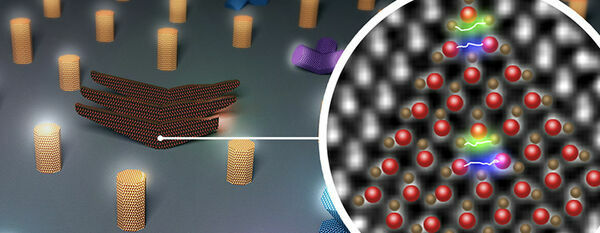
Tune in to future polarity quantum devices
"A thorough study published on NanoLetters and led by the ICN2 Advanced Electron Nanoscopy group provides new insights on the growth mechanisms and conditions that determine the polarity of semiconductor nanostructures. Fine control of polarity can result in the design of new quantum devices. Future applications of nanomaterials depend on our ability to understand their characteristics at the atomic scale and to modulate them at will. Polarity appears to play an important role in determining the physical and morphological properties of semiconductor nanostructures, thus researchers are studying how to control or change it. Because of the way atoms are arranged in crystal structures, electromagnetic charges are locally separated. As a consequence, if we look at the crystal along specific directions, we can observe oppositely-charged ionic couples, which are called dumbbells because of their shape." [...]
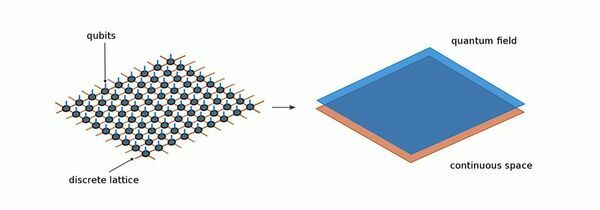
A Leap into the Continuum
"Garching physicists develop a new method to carry computations in quantum field theory. Computing the dynamics of many interacting quantum particles accurately is a daunting task. There is however a promising calculation method for such systems: tensor networks, which are being researched in the theory division at the Max Planck Institute of Quantum Optics. The initial focus of tensor network was on quantum particles restricted to a lattice, just as they occur in crystals for example, or in the quantum registers of future quantum computers. In a new paper, the postdoctoral researcher Antoine Tilloy and the theory division director Ignacio Cirac managed to extend this approach to the continuum. A goal in the long run is an elegant calculation method for the quantum field theories that describes the basic forces of physics." [...]

Quantum – a double-edged sword for cryptography
"Quantum computers pose a big threat to the security of modern communications, deciphering cryptographic codes that would take regular computers forever to crack. But drawing on the properties of quantum behaviour could also provide a route to truly secure cryptography. Defence, finance, social networking – communications everywhere rely on cryptographic security. Cryptography involves jumbling up messages according to a code, or key, that has too many combinations for even very powerful computers to try out. But quantum computers have an advantage. Unlike regular computers, which process information in ‘bits’ of definite ones and zeros, quantum computers process information in ‘qubits’, the states of which remain uncertain until the final calculation." [...]
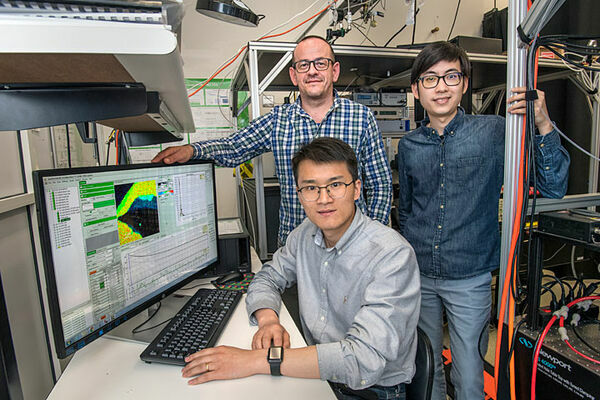
Hybrid Nanostructure Steps Up Light-Harvesting Efficiency
"A stepwise transfer of energy through the different components of the nanostructure—from light-excited semiconducting nanocrystals to a protein to an atomically thin semiconductor—boosts its response to light, showing promise for solar cell applications To absorb incoming sunlight, plants and certain kinds of bacteria rely on a light-harvesting protein complex containing molecules called chromophores. This complex funnels solar energy to the photosynthetic reaction center, where it is converted into chemical energy for metabolic processes. Inspired by this found-in-nature architecture, scientists from the U.S. Department of Energy’s (DOE) Brookhaven National Laboratory and Stony Brook University (SBU) have assembled a nanohybrid structure that contains both biologically derived (biotic) and inorganic (abiotic) materials. They combined a light-harvesting protein from a cyanobacteria, semiconducting nanocrystals (quantum dots), and a two-dimensional (2-D) semiconducting transition metal only one atomic layer thick. Described in a paper published on April 29 in ACS Photonics—a journal of the American Chemical Society (ACS)—this nanostructure could be used to improve the efficiency with which solar cells harvest energy from the sun. “Today’s best solar panels can convert nearly 23 percent of the sunlight they absorb into electricity, but on average, their efficiency ranges between 15 and 18 percent,” said corresponding author Mircea Cotlet, a materials scientist in the Soft and Bio Nanomaterials Group at Brookhaven Lab’s Center for Functional Nanomaterials (CFN)—a DOE Office of Science User Facility." [...]

Algorithm tells robots where nearby humans are headed
"A new tool for predicting a person’s movement trajectory may help humans and robots work together in close proximity. In 2018, researchers at MIT and the auto manufacturer BMW were testing ways in which humans and robots might work in close proximity to assemble car parts. In a replica of a factory floor setting, the team rigged up a robot on rails, designed to deliver parts between work stations. Meanwhile, human workers crossed its path every so often to work at nearby stations. The robot was programmed to stop momentarily if a person passed by. But the researchers noticed that the robot would often freeze in place, overly cautious, long before a person had crossed its path." [...]

Mass Anomaly Detected Under the Moon’s Largest Crater
"Discovery may contain metal from asteroid crash, Baylor University researcher says A mysterious large mass of material has been discovered beneath the largest crater in our solar system — the Moon’s South Pole-Aitken basin — and may contain metal from an asteroid that crashed into the Moon and formed the crater, according to a Baylor University study. “Imagine taking a pile of metal five times larger than the Big Island of Hawaii and burying it underground. That’s roughly how much unexpected mass we detected,” said lead author Peter B. James, Ph.D., assistant professor of planetary geophysics in Baylor’s College of Arts & Sciences. The crater itself is oval-shaped, as wide as 2,000 kilometers — roughly the distance between Waco, Texas, and Washington, D.C. — and several miles deep. Despite its size, it cannot be seen from Earth because it is on the far side of the Moon. The study — ”Deep Structure of the Lunar South Pole-Aitken Basin” — is published in the journal Geophysical Research Letters." [...]
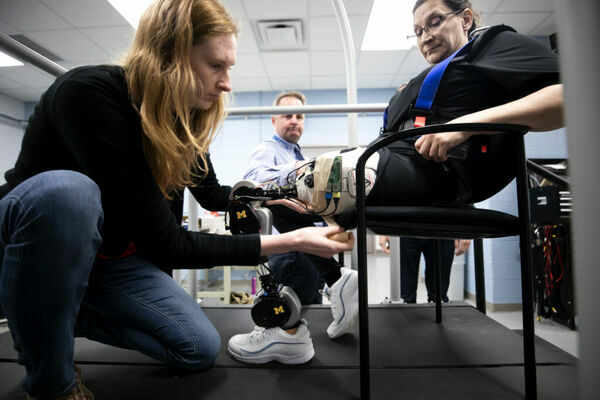
Open-source bionic leg: First-of-its-kind platform aims to rapidly advance prosthetics
"A new open-source, artificially intelligent prosthetic leg designed by researchers at the University of Michigan and Shirley Ryan AbilityLab is now available to the scientific community. The leg’s free-to-copy design and programming are intended to improve the quality of life of patients and accelerate scientific advances by offering a unified platform to fragmented research efforts across the field of bionics. “Our Open-Source Bionic Leg will enable investigators to efficiently solve challenges associated with controlling bionic legs across a range of activities in the lab and out in the community,” said lead designer Elliott Rouse, core faculty at U-M’s Robotics Institute and assistant professor of mechanical engineering. “In addition, we hope our bionic leg will unite researchers with a common hardware platform and enable new investigators from related fields to develop innovative control strategies.” Rouse and collaborator Levi Hargrove, director of the Center for Bionic Medicine at the Shirley Ryan AbilityLab in Chicago, will unveil the leg and its online platform at the Amazon re:MARS conference in Las Vegas. Details on where to order the parts, how to put them together and how to program the leg are available at opensourceleg.com. Hargrove, who is also an associate professor of physical medicine and rehabilitation and biomedical engineering at Northwestern University, is already using the leg in clinical studies." [...]

Decoding the Mathematical Secrets of Plants’ Stunning Leaf Patterns
"A Japanese shrub’s unique foliage arrangement leads botanists to rethink plant growth models To the untrained eye, plants may appear to grow rather impulsively, popping out leaves at random to create one big green jumble. Take a closer look, though, and you’ll find that a few curiously regular patterns pop up all over the natural world, from the balanced symmetry of bamboo shoots to the mesmerizing spirals of succulents. In fact, these patterns are consistent enough that cold, hard math can predict organic growth fairly well. One assumption that has been central to the study of phyllotaxis, or leaf patterns, is that leaves protect their personal space. Based on the idea that already existing leaves have an inhibitory influence on new ones, giving off a signal to prevent others from growing nearby, scientists have created models that can successfully recreate many of nature’s common designs. The ever-fascinating Fibonacci sequence, for example, shows up in everything from sunflower seed arrangements to nautilus shells to pine cones." [...]
Modelos 3D
Com a disponibilidade de ferramentas que permitem dar azo a nossa imaginação na criação de peças 3D e espaços como o thingiverse para as publicar, esta rubrica apresenta alguns modelos selecionados que poderão ser úteis.
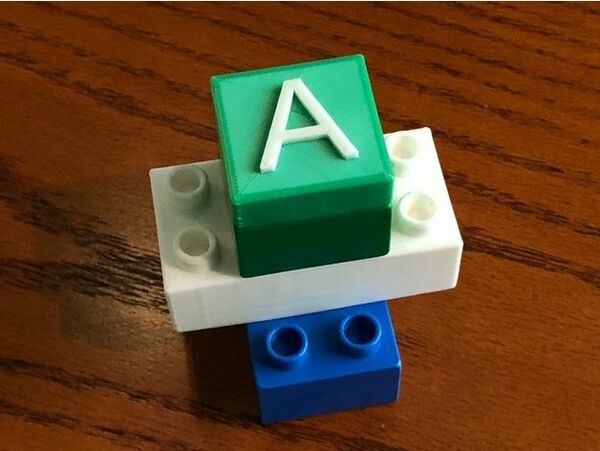
Adjustable Improved Duplo Brick Generator with Text
"I'm teaching myself to code 3D in OpenSCAD, so I thought I would add the basic 3D text on a cube function that's in the OpenSCAD examples so that studless blank block tops can become fun LETTERS, NUMBERS and SYMBOLS! I printed a couple un-remixed standard bricks and noticed that they are too hard to assemble, so I have tweaked the stud design by adding a sloped area to ease alignment, shown in green in the preview. Since I own a crappy dual extruder printer I thought I would make it possible to generate the letter and brick separately so they can be printed with distinct colours. This has the side effect of being able to generate an embossed brick with adjustable letter inset depth. You can make the colour letter flush with the top of the brick so it's a non-protruding inlay by making the letter height the same as the embossed inset. You can also try no inset and switching filament on the first letter layer to use a regular machine to create the 2 colour design." [...]
Documentação
A documentação é parte essencial do processo de aprendizagem e a Internet além de artigos interessantes de explorar também tem alguma documentação em formato PDF interessante de ler. Todos os links aqui apresentados são para conteúdo disponibilizado livremente pelo editor do livro.
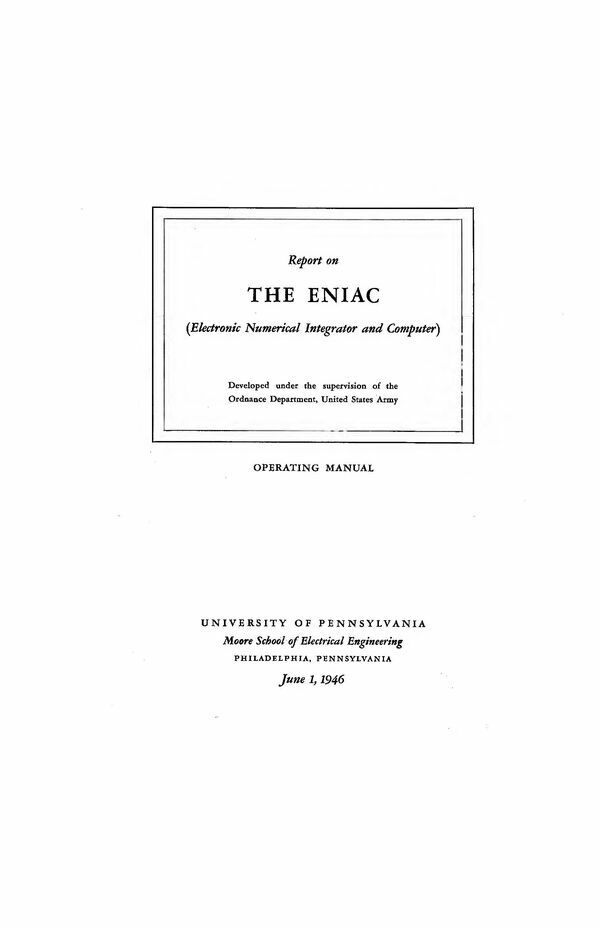
THE ENIAC (Electronic Numerical Integrator and Computer) - Operating Manual
"A look at the ENIAC Operating Manual, published 75 years ago this month, reveals just how difficult it was to program the world's first electronic general-purpose computer and how frustrating it must have been for its programmers. When did you last read the operating manual of a computer, or any other electronic device for that matter? As programmers we tend to ignore any type of guidance, at least until something goes wrong and these days that rarely happens. But 75 years ago ENIAC's programmers probably did need to consult printed documentation to instruct them which switches to use and in which order. In this photo both Glen Beck and Betty Snyder, who are engaged in the task of programming ENIAC, appear to be holding documentation. " [...]
Projetos Maker
Diversos Projetos interessantes.
Arduino Clock with Neopixel Ring Animation
"Yet another useless Arduino clock, but i love it. According to Larry Wall there are three great virtues of a programmer: Laziness, Impatience and Hubris. I have all of them. Unfortunately my programs are not the treasure. So what should I do? use the Arduino." [...]
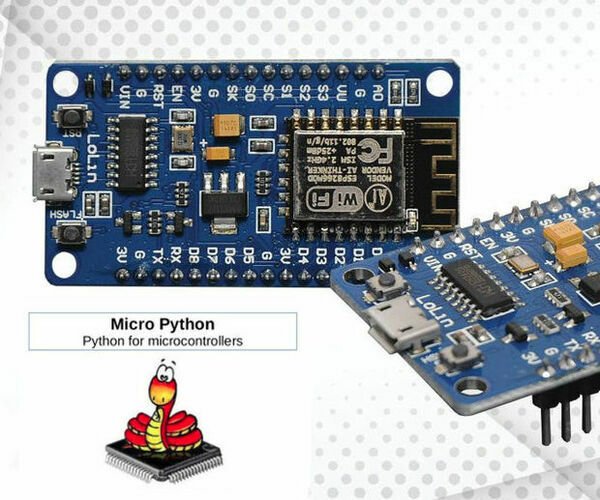
Getting Started With MicroPython on the ESP8266
"Do you want a different way to program the ESP8266-based boards rather than the common method using Arduino IDE along with C/C++ programing language ? In this tutorial we will learn who to configure and control an ESP8266 board using MicroPython. BUILD TIME: 60 MINUTES DIFFICULTY: RATING: Easy MicorPython is one of the many programming language that can we use to program the ESP8266 module. It is a lean and fast version of the Python 3 programming language and has several advantages over traditional programming languages such as C and C++. MicroPython is designed to be compatible with normal Python as much as possible. It has a complete Python compiler and runtime, and provides an interactive prompt known as REPL (Read-Eval-Print Loop)." [...]
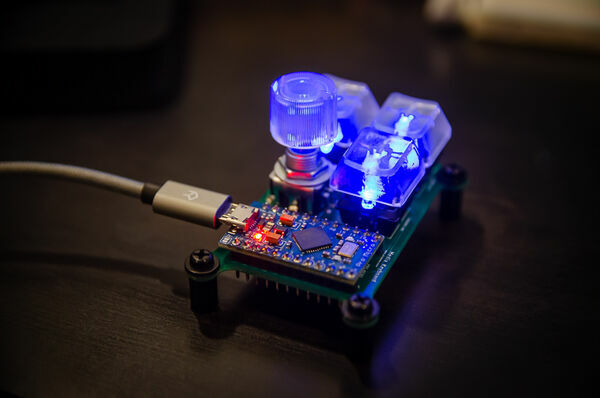
USB Mini Media Keyboard
"For my latest electronics project, I’ve built a small USB keyboard input device for media control. The final version has three keys: play/pause, previous track, and next track. In addition, a rotary encoder allows adjusting the volume (or mutes sound when pressed). This is also my first project involving a custom circuit board — my previous electronics projects mainly involved breadboards of varying sizes. The project is based on a Pro Micro, an Arduino-compatible ATmega 32u4 board (the 32u4 allowing to easily create USB devices). For iteration 1, I added a couple of buttons and a rotary encoder to a breadboard alongside the Pro Micro to see how I can get media controls over USB to work." [...]
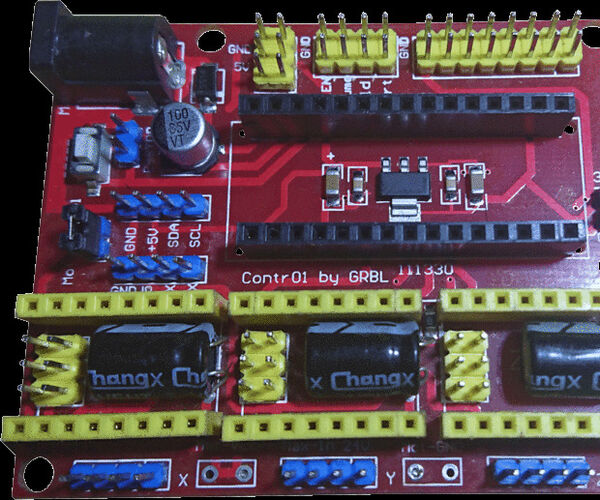
Fix Cloned Arduino NANO CNC Shield
"Modifying Clone Keyes CNC Shield. One the web are Chinese cloned Keyes CNC Shields for the Arduino NANO. They are cheep and good value. BUT. If you want to set Micro Stepping as they are, you can't. Who ever cloned/made this shield made a mistake and put the pins that should go to Vcc, to GND." [...]
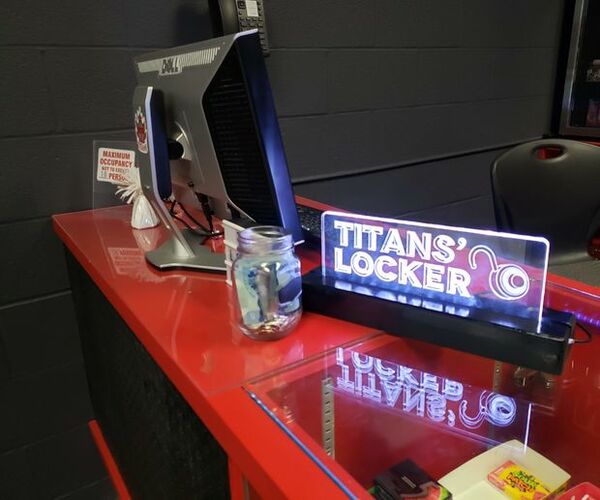
Totally Lit - Programmable RGB LED Acrylic Sign
"Been playing around with the laser cutter/engraver, and really fell in love with engraving in to clear acrylic and shining a light source from the edge. The thickness of the acrylic being used is a .25" sheet, which cuts really cleanly by the laser cutter/engraver (the one that I had access to is the Trotec 300). Started off with a simple OPEN sign with a single light colour source, and have moved on to using programmable RGB LEDs Things needed for this Instructable: access to a laser cutter/engraver (however you could get the same effect with clear acrylic and fine use of sand paper - though it's a lot more work this way) Software to design the vector image (I used Adobe Illustrator) RGB LEDs Arduino Nano Push button Wiring Wood (scraps were used in this case) screws/glue AC/DC power adapter (5V was used here - I repurposed old AC adapters from other devices that have been long past their use, such as old mobile phones and their charging adapters that were included with them) spray paint (optional)" [...]
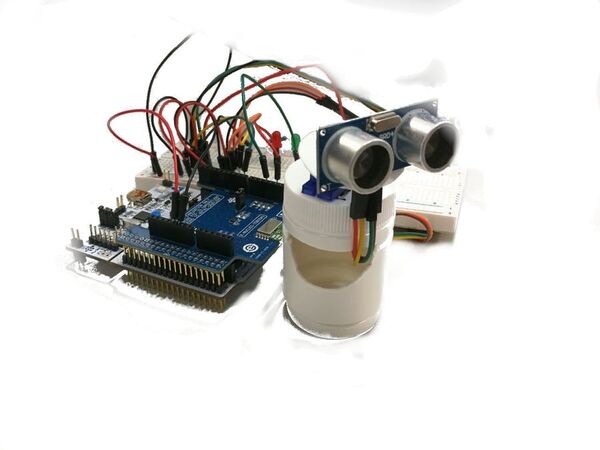
Spider Sense
"An IoT project for preventing attacks from behind through Android app and Nucleo-board. The idea Our idea was to use an ultrasonic sensor attached to a servo motor to make possible an obstacle detection at 180 degrees and to implement from that an application capable of triggering and broadcasting an alarm to the users. This was thought to be applicable in all the situations in which you cannot see what's happening in a certain area. Suppose you are a private guard who has to keep watch without someone "watching your back." Or suppose you want to have a way to see in your smartphone how much your car is near to the wall when you're parking in your garage. Or even imagine a blind person that with a simple buzzer replacing radar animation or through vibration, can understand to be in front of an obstacle." [...]
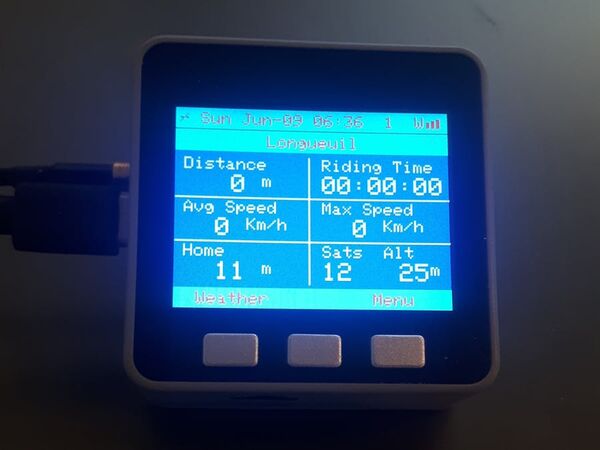
M5Stack GPS Logger
"GPS logger that stores your location into a GPX file with a back end web server to view daily rides, add comments and multi-media files. I love to ride my motorcycles! When I go out riding, I typically plan my route using ITN Converter and transfer the itinerary file to my TomTom Rider 1 gps. Now while following this planned route, there's more often than not deviations along the way and the actual ride can vary quite a bit from the planned route. So the initial thought behind this project was to log the GPS latitude and longitude position information every 10 seconds into a GPX file (the GPS eXchange Format) that I could retrieve later and view the actual ride in ITN Converter (which is also capable of reading these files). Sounds pretty simple, right?" [...]
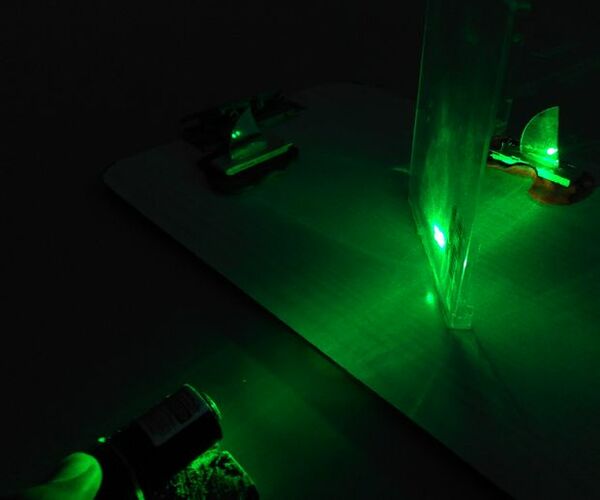
Make Your Own Really Cheap Interferometer
"Hello Everyone! Welcome to another instructable by Let's Innovate. In this instructable I will guide you to make your very own really cheap interferometer. Emphasis on the "really cheap" part because there are many costly kits out there you can buy but by following this tutorial you will be able to make your very own interferometer that will cost you nothing! And does not even require that much time to setup! This project was part of my entry to the CAIE Science Project." [...]
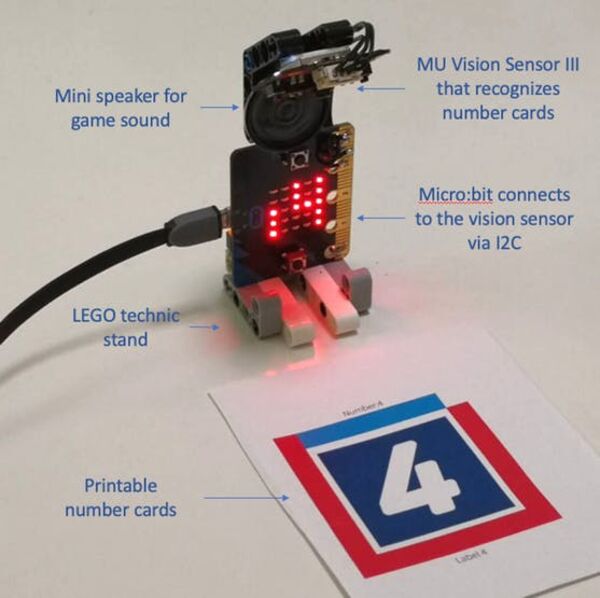
Mini "Guess the Number" Game Machine with Micro:bit
"Build a fun mini "Guess the Number" game machine using a micro:bit board and the compact MU Vision sensor, and program it using MakeCode! Have you ever played "Guess the Number"? This is a very easy-to-build mini game machine that plays "Guess the Number" with you. We designed this DIY project to encourage physical play and help kids learn programming. It uses a MU Vision sensor to sense the number cards, through which the player will try to guess the random number that the machine has chosen. " [...]
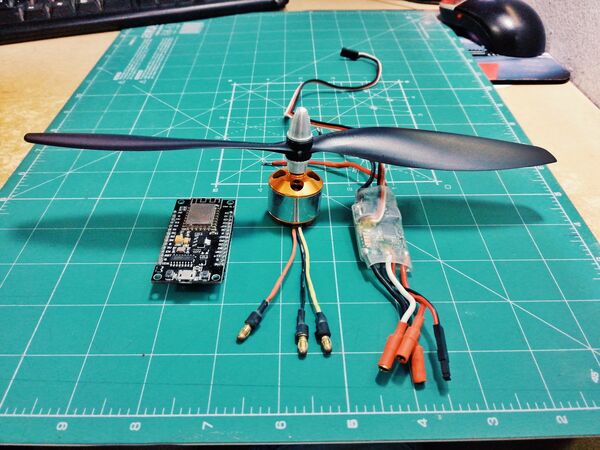
Speed Control for Brushless Motors With an ESP8266
"What are Brushless motors? Also known as synchronous DC motors, they are an special type of motor that consist on a stator and a rotor as most of the motors out there, but with a difference, "brushless motors" ,as it name tell us, do not have brushes electrically connected between the stator and the rotor to reduce friction, vibrations, inefficiency. How do they work? These motors are associated with an inverter. The inverter makes the supply voltage to the coils sequentially, thus the poles of the rotor move according to the magnetic field generated by the coils sequentially. The speed of the rotor and its axis, will depend on the speed of sequencing of the variator." [...]
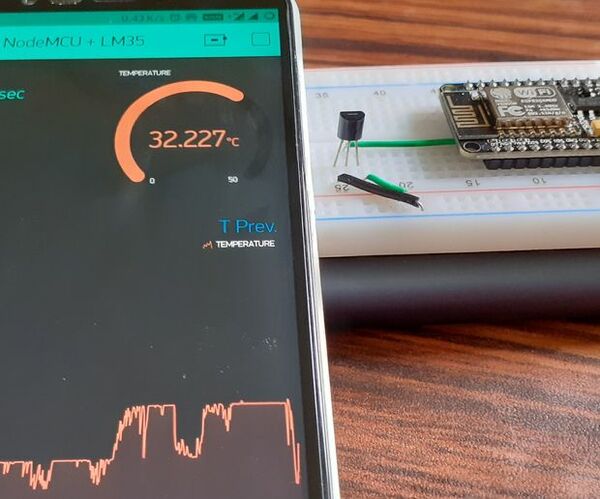
ESP8266 NodeMCU + LM35 + Blynk ( IOT Weather Station/ Digital Temp Sensor)
"Hi guys! In this Instructable, we're going to learn how to interface LM35 sensor to NodeMCU and Display that temperature info over the internet on a smartphone with Blynk application. (Also in this project we will be using SuperChart widget in the Blynk application so the data gets stored in the Blynk cloud and we get to see all the past data in a chart. In short, no sensor data is lost and you get to see a cool looking graph. ) Supplies:Getting started... List of items needed for this project 1." [...]
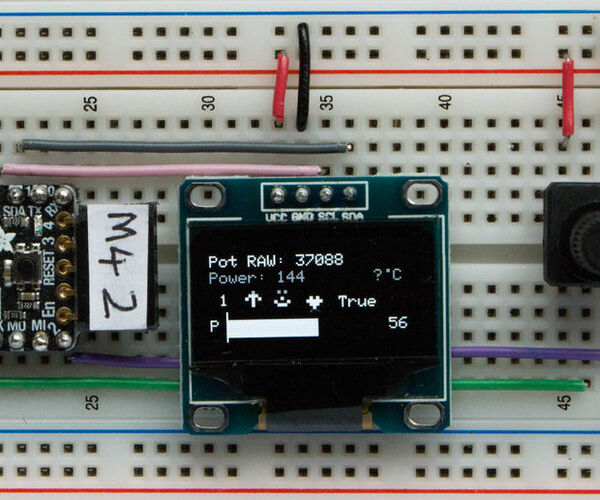
Graphics on a SSD1306 I2C OLED 128x64 Display With CircuitPython Using an Itsybitsy M4 Express
"The SSD1306 OLED display is a small (0.96"), inexpensive, widely available, I2C, monochrome graphical display with 128x64 pixels, which is easily interfaced (only 4 wires) to microprocessor development boards such as a Raspberry Pi, Arduino or Adafruit Itsybitsy M4 Express, CircuitPlayground Express or other CircuitPython devices. Drivers can be downloaded from the internet. Graphical routines for Arduinos have been available for some time but not for other development systems. The basic device drivers allow users to : Clear the screen to black or white. oled.fill(c) Write a text string to the screen at a specified (x, y) position oled.text("Text", x, y, c) Draw a dot at a specified (x, y) position oled.pixel(x, y, c) Load a picture file to the screen. (Not used in this project) Update the display oled.show() This Instructable will demonstrate, with simple procedures, how to draw, interactively: lines circles hollow boxes solid blocks pre-defined characters I will be using an Adafruit Itsybitsy M4 Express to demonstrate the methods but the code, in Python, can easily be ported to other development systems." [...]
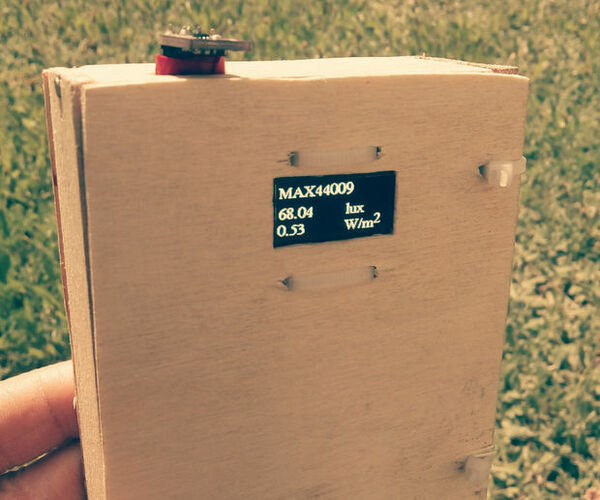
Portable Luxmeter
"This project is about making portable luxmeter. It can be used in schools, where children can measure different kinds of light sources. Functions: 1. measure intensity of light in lux. 2. calculate solar irradiation from lux to watts/m2 (factor 112) 3. charging battery using USB port Total cost is around 13 $ without case. Luxmeter take 15 mA, so it will works long time on one Li-Ion battery. " [...]
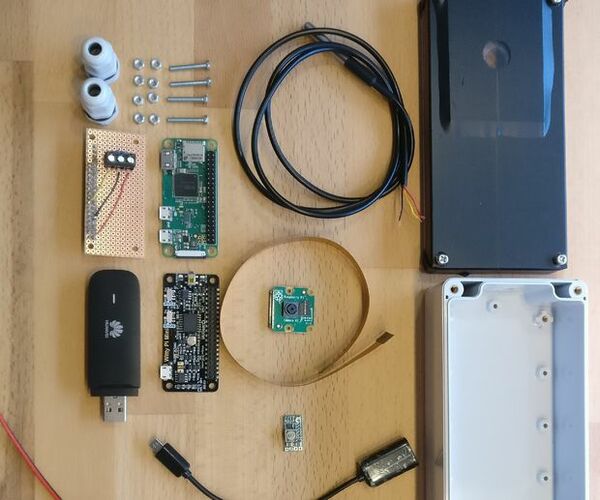
Automated River Water Monitoring System
"This instructable is used to document the development of an automated river water monitoring system. The monitored parameters are the water level and water temperature. The goal of this project was to develop a low-cost and independent Logger that is connected to a database. The water level is monitored with a special QR-level. A camera in the Pi is taking a picture every 15 min. The QR-codes in this picture get decoded by software and are indicative to the actual water level." [...]
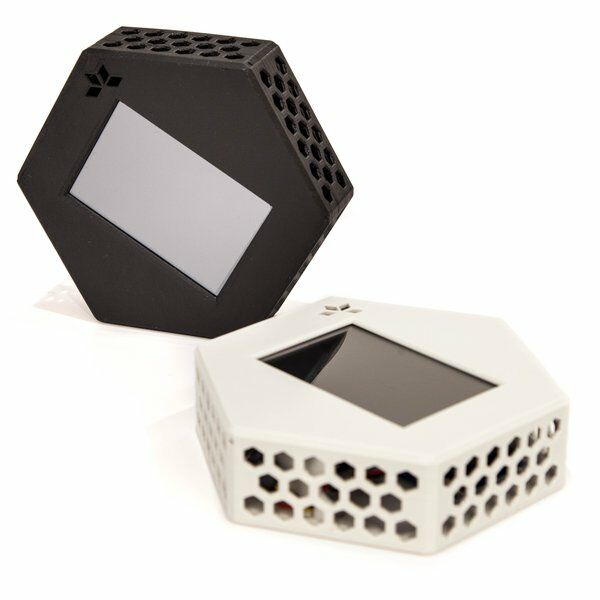
HestiaPi Touch - Open Smart Thermostat
"Open source hardware smart thermostat for your home. HestiaPi Touch is a completely open source smart thermostat for your home. With it, you can monitor your homes temperature, relative humidity, and atmospheric pressure. You can also control your heating, ventilation, air conditioning, hot water, and more from anywhere you have an Internet connection. You can do all this securely and with confidence your private data stays private. HestiaPi Touch is compatible with many devices and home automation systems and can serve as a central point of control that ties them all together in your home." [...]
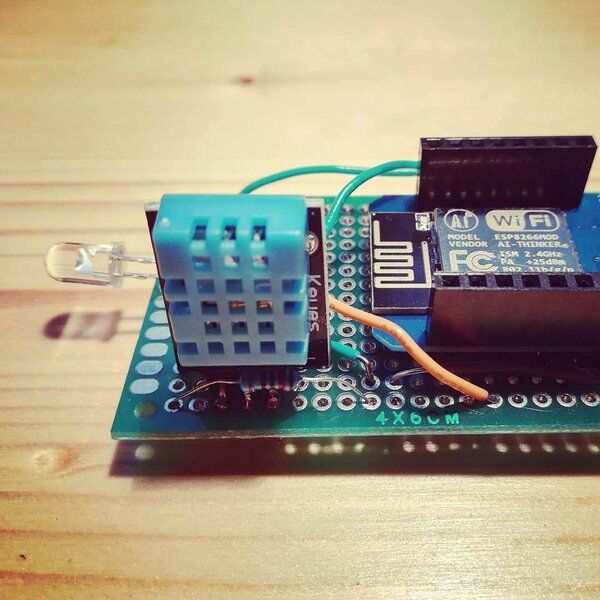
Normal air conditioner becomes wifi controlled
"The standard air conditioner not connected you already have can be hacked to be used with a smartphone I've got a standard Daikin air conditioner in my home, it's not a connected device. It's controlled only by an infra-red remote controller. I've made it wifi controlled emulating the infra-red remote controller commands with an ESP8266 microcontroller. This new controller can be placed in a place that "see" the air conditioner and using a small app can talk with an Ios/Android smartphone. " [...]
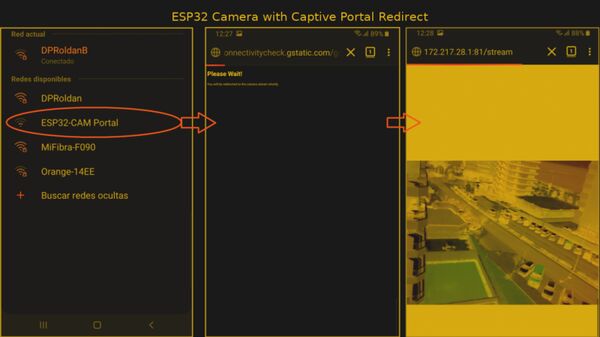
Esp32AutoCamera
"ESP32-CAM with an open wifi access point and a captive portal, for fast deployment of a wireless camara. This is a mash-up of some of the example programs for the ESP32 device. The goal is to have a inmediate way to access a camera stream without any configuration or security. The ESP32-CAM is configured as an access point, it has a DNS server to act as a captive portal, so your when device (phone, laptop, etc) connects, it should open a "login" page that redirects you to the actual stream. Working fine with Windows, Android, MacOS and iPhone. In Windows, your browser may have redirects disabled, so you may need to confirm the redirection." [...]
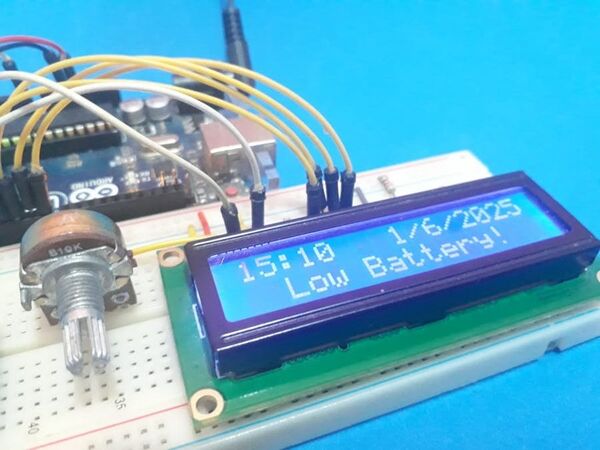
Real-Time Clock Battery Monitoring System
"In this article, you will learn how to implement a feature to monitor the real-time clock battery and prevent problems in the circuit. Introduction On several systems that use time and date to perform certain tasks, it is critical to use real-time clock chips. But one of the big problems is that it needs a battery to, keep the time and date count when the system is off. On the computer, for example, we have a Real Time Clock and when the battery is low voltage, the time and date are displayed with wrong values. So, to solve this problem in projects, we can monitor the battery voltage. Thus, when the battery is below a limit value, the system will generate an alarm in order to perform the exchange." [...]
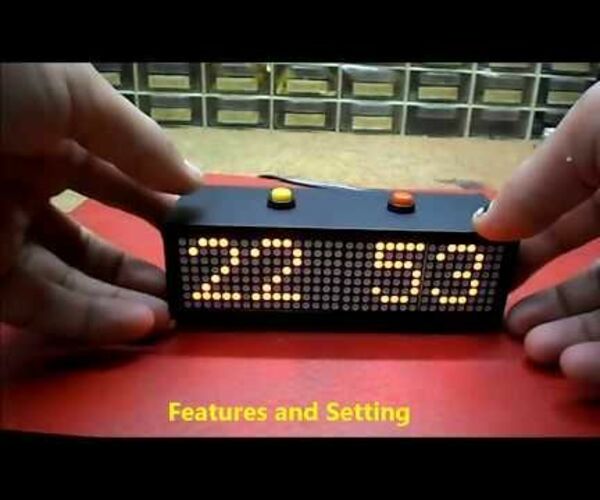
Arduino Nano Mini LED Matrix Clock
"Beautiful simple matrix clock with many features On "Nick's LED Projects" page I found clock project witch show the time on 4 matrices with 8x8 leds. He built the clock with matrices from "icstation" store who sells Matrix Module Panel DIY Kits. With a minimal change in the code, I made my clock with MAX7219 Dot Matrix Module Microcontroller 4 In One Display which is completely folded and is much cheaper. I purchased it from Aliexpress:(https://www.aliexpress.com/item/MAX7219-Dot-Matrix-Module-Microcontroller-4-In-One-Display-with-5P-Line/32841678065.html?spm=a2g0s.9042311.0.0.27424c4ddRkHVN) The clock has many features : -Basic mode with large digits -Slide mode where digits roll on and off screen -Small digits with seconds mode -Time written in words e.g. “Ten past Twelve” -Date display -12/24 hour option -Brightness option -Random clock mode option that changes the display mode every few hours. -Push button driven menus for setup & display selection." [...]
Movie Tracker - Raspberry Pi Powered Theatrical Release Tracker
"Movie Tracker is a clapperboard shaped, Raspberry Pi-powered Release Tracker. It uses the TMDb API to print the poster, title, release date and overview of upcoming movies in your region, in a specified time interval(eg. movie releases this week) on thermal paper. There is a LED on the back of the board that lights up when there are new releases. Also, It has two magnets so you can attach the movies you want to watch on the board. Outline In the first step, I'll talk about the Idea behind this project." [...]
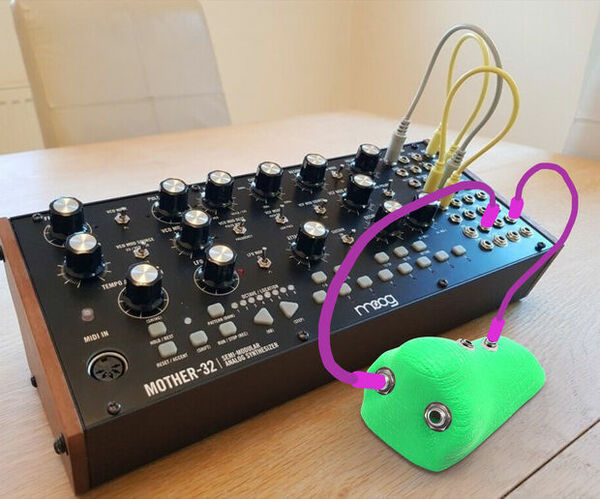
Human Multiplier
"Every synth-nerd needs multipliers. If you don't have a multiplier it is like missing salt in your kitchen. It is not that sophisticated, but it is very important. However, almost every multiplier available is a boring sheet of metal with a couple of jack sockets screwed on it. Since it is a very simple circuit to build, why don't we make it a bit more interesting? For this reason I created the "Human Multiplier"." [...]
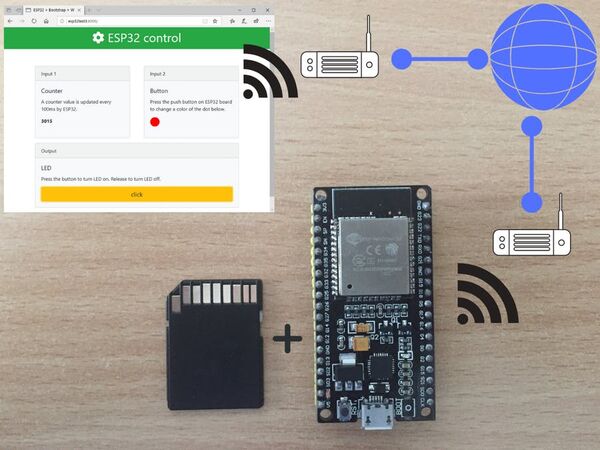
Host Web Page Over the Internet on ESP32 Using SD Card
"ESP32 + HTTP server + WebSockets + Bootstrap + Husarnet + configuration and HTML files on SD card. This project template is a good base for creating internet-controlled devices with a web UI and easy configuration capability. Here main advantages of that template: I. CONFIGURATION USING SD CARD One of the biggest problems in making connected things is the first configuration. Opening IDE just to change network credentials or HTML is uncomfortable and takes to much time. Other options would be dedicated mobile app that you will use probably only once or CLI over serial port to your things (it's so easy to make a typo and redo the whole configuration again). " [...]
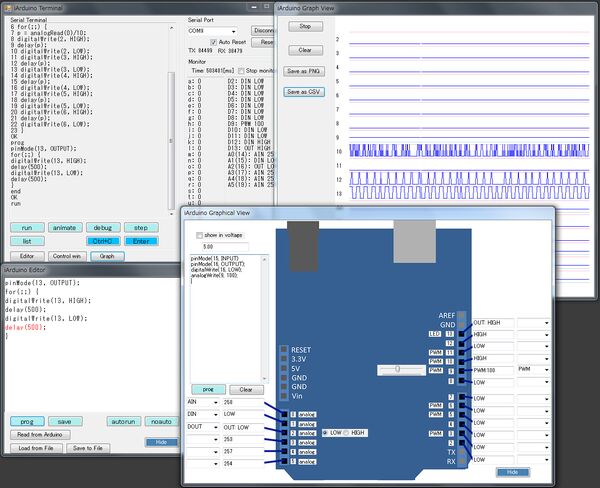
iArduino: a C Interpreter for Arduino
"The iArduino is an interpreter which runs on Arduino board. Interpreted language is a programming language in which programs are 'indirectly' executed ("interpreted") by an interpreter program (see Wikipedia.) The iArduino interprets a language which resembles to the Arduino language. It can evaluate an expression refelctively, do stepwise executtion of a program, run a program slowly, stop and resume a program. " [...]
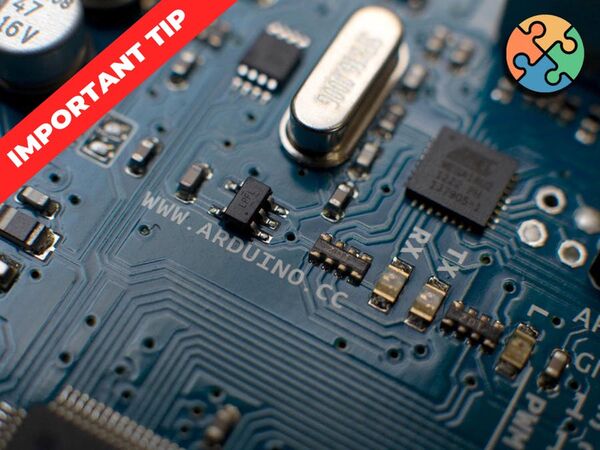
Increase the Electrical Current Capacity of the Arduino Pins
"Learn how to create a circuit to increase the electrical current of the Arduino pins to activate loads that need more electrical current. Introduction Between the several types of Arduino and other Microcontrollers, we have a problem: the low capacity of electrical current sourcing of the pins. Where this value can vary between 6 mA to 40 mA in some models. But be careful, always check the datasheet of your device and check the electrical current sourcing capacity of the pins. But now, to solve this problem, we will use an electrical current driver circuit and we will present all step by step to you construct your own circuit of simple way. Project Development Through the presented problem, the circuit allows you to drive a load whose electrical current is higher than the pin of the Microcontroller can provide." [...]
That's all Folks!



